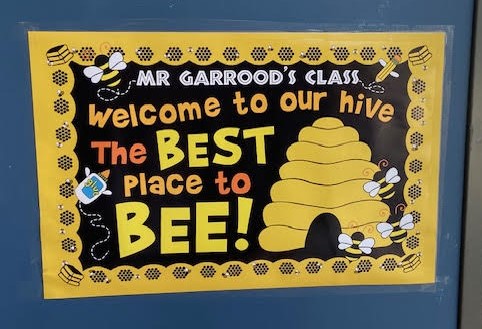Lincoln Elementary School teacher Owen Garrood instructed his students to come to school dressed in yellow and black.
by David Goldstein
Honeybees work all day in service to their hive, and their pollination is essential for the growth of many plants, but the whole venture is sustainable only because the bees are paid. The payment is made by plants in the form of nectar. The lesson: work must be rewarded to be sustainable.
Lessons from honeybees were also applied to human society shortly after National Bee Day, was the third Saturday in August, by an innovative teacher at Lincoln Elementary School in Ventura. Owen Garrood, known as “Mr. G” to his kindergarten students, instructed his students to come to school dressed in yellow and black. He wore a yellow and black striped shirt, and they all wore antennae head bands. Mr. G noted, “Using color as a theme” creates “a community feel… connects them to their classroom and unites them as a group.”
Even bees’ buzzing sound was part of his lesson. As instructed, the kids made a low, buzzing sound as they walked across the courtyard and through the school. As he wrote to me in an email, “It is scientifically proven that the vibrations made in the throat cause the mind to settle and calm anxiety; hence the reason they use it in yoga.”
Last month, other organizations also used the occasion of National Bee Day to schedule educational outreach. At an event on August 31, the Museum of Ventura County hosted an event educating the public about pollinators such as honeybees and monarch butterflies. The museum, in Ventura, hosted presenters from the Ventura office of the California Department of Fish and Wildlife. Participants planted yarrow seeds in pots they personalized and were allowed to keep.
Bee Day at the Ventura County Agricultural Museum in Santa Paula, on August 19, had many more activities. Dozens of children scurried from crafts to displays and entertainment. Children made candles from wicks rolled into small sheets of bee’s wax, and presenters gave context to a year-round highlight of the museum — a working beehive. The hive, on permanent display within the museum, is fully enclosed with transparent plastic, but has an access port to flowers and plants outside.
During the remainder of the school year, Students for Education and Agriculture, SEEAG, a non-profit organization serving schools throughout Ventura County, will teach students about the importance of honeybees and other pollinators to local agriculture. Their third-grade education program, Farm Lab, observes pollinators at work amidst lemon blossoms. SEEAG’s middle and high school programs, which focus on agricultural careers, spotlight local insectaries, beekeepers, and companies working to preserve and cultivate pollinators, according to SEEAG Education Director Seth Wilmoth
Just as flowers “pay” bees with nectar, human society must also pay a debt to pollinators if we want to sustain their work. You can see the types of plants best suited to sustain the work of pollinators at the Ventura County Government Center’s two pollinator gardens. The newer of the two consists of two planters between the Hall of Justice cafeteria and the Hall of Administration north entrance. In addition to plant selection, using only organic pest control methods in those gardens also boosts pollinator populations, according to General Services Agency facilities manager Patrick Squires.
David Goldstein, Environmental Resource Analyst with the Ventura County Public Works Agency, may be reached at (805) 658-4312 or [email protected]

